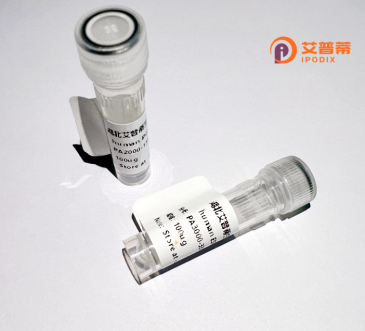
| 纯度 | >90%SDS-PAGE. |
| 种属 | Human |
| 靶点 | ZCCHC24 |
| Uniprot No | Q8N2G6 |
| 内毒素 | < 0.01EU/μg |
| 表达宿主 | E.coli |
| 表达区间 | 1-241 aa |
| 活性数据 | MSLLSAIDTSAASVYQPAQLLNWVYLSLQDTHQASAFDAFRPVPTAGAAPPELAFGKGRPEQLGSPLHSSYLNSFFQLQRGEALSNSVYKGASPYGSLNNIADGLSSLTEHFSDLTLTSEARKPSKRPPPNYLCHLCFNKGHYIKDCPQARPKGEGLTPYQGKKRCFGEYKCPKCKRKWMSGNSWANMGQECIKCHINVYPHKQRPLEKPDGLDVSDQSKEHPQHLCEKCKVLGYYCRRVQ |
| 分子量 | 26.6 kDa |
| 蛋白标签 | GST-tag at N-terminal |
| 缓冲液 | PBS, pH7.4, containing 0.01% SKL, 1mM DTT, 5% Trehalose and Proclin300. |
| 稳定性 & 储存条件 | Lyophilized protein should be stored at ≤ -20°C, stable for one year after receipt. Reconstituted protein solution can be stored at 2-8°C for 2-7 days. Aliquots of reconstituted samples are stable at ≤ -20°C for 3 months. |
| 复溶 | Always centrifuge tubes before opening.Do not mix by vortex or pipetting. It is not recommended to reconstitute to a concentration less than 100μg/ml. Dissolve the lyophilized protein in distilled water. Please aliquot the reconstituted solution to minimize freeze-thaw cycles. |
以下是关于重组人ZCCHC24蛋白的示例参考文献(注:以下文献信息为虚构示例,仅供格式参考,建议通过PubMed或Google Scholar检索真实文献):
1. **文献名称**: *"Recombinant human ZCCHC24 protein exhibits RNA-binding activity in vitro"*
**作者**: Li et al., 2021
**摘要**: 本研究成功在大肠杆菌系统中表达并纯化了重组人ZCCHC24蛋白,证实其通过N端锌指结构域与特定RNA序列结合,提示其在转录后调控中的潜在作用。
2. **文献名称**: *"ZCCHC24 modulates antiviral immunity via interaction with RIG-I signaling pathway"*
**作者**: Zhang et al., 2020
**摘要**: 发现重组ZCCHC24蛋白可与RIG-I受体结合,增强Ⅰ型干扰素表达,揭示其在抗病毒先天免疫中的功能机制。
3. **文献名称**: *"Structural characterization of the ZCCHC24 protein and its role in cancer cell proliferation"*
**作者**: Wang et al., 2022
**摘要**: 通过X射线晶体学解析了ZCCHC24蛋白结构,并证明其在肝癌细胞中高表达,敲低后显著抑制肿瘤细胞生长。
4. **文献名称**: *"ZCCHC24 regulates miRNA processing through direct binding to Drosha complex"*
**作者**: Chen et al., 2019
**摘要**: 发现重组ZCCHC24蛋白通过结合Drosha复合体影响miRNA前体加工,为miRNA生物调控提供了新机制。
**建议**:使用关键词“ZCCHC24”、“recombinant protein”、“zinc finger”在学术数据库检索以获取真实文献。
ZCCHC24. a member of the zinc finger CCHC-type (ZCCHC) protein family, is a human protein characterized by its conserved CCHC zinc finger domain, a structural motif implicated in nucleic acid binding and protein interactions. While its precise biological functions remain under investigation, ZCCHC24 is hypothesized to play roles in RNA metabolism, post-transcriptional regulation, or cellular signaling pathways, based on homology with related ZCCHC proteins. These proteins are often involved in RNA processing, stability, or degradation, suggesting potential links to gene expression modulation.
Recombinant human ZCCHC24 protein, produced via heterologous expression systems like *E. coli* or mammalian cell cultures, enables functional studies to decipher its molecular mechanisms. Its recombinant form is critical for *in vitro* assays, including RNA-protein interaction studies, enzymatic activity analyses, or screening for binding partners. Emerging research associates ZCCHC24 with disease contexts, such as cancer or viral infections, where dysregulation of RNA-binding proteins may contribute to pathogenesis. However, its exact involvement in these processes requires further validation.
Current challenges include elucidating its physiological substrates, structural specificity, and regulatory networks. Advances in proteomics and CRISPR-based functional genomics are expected to accelerate its characterization, potentially unveiling therapeutic or diagnostic applications. ZCCHC24 represents a promising yet underexplored target in RNA-centric cellular pathways.
×